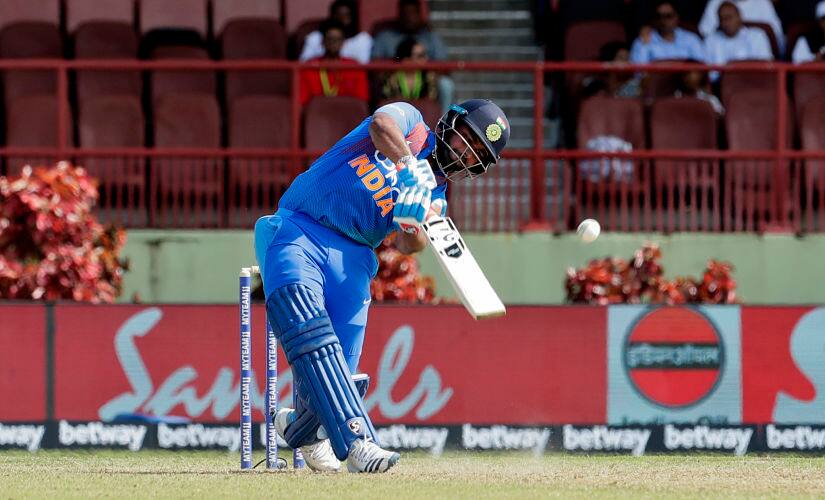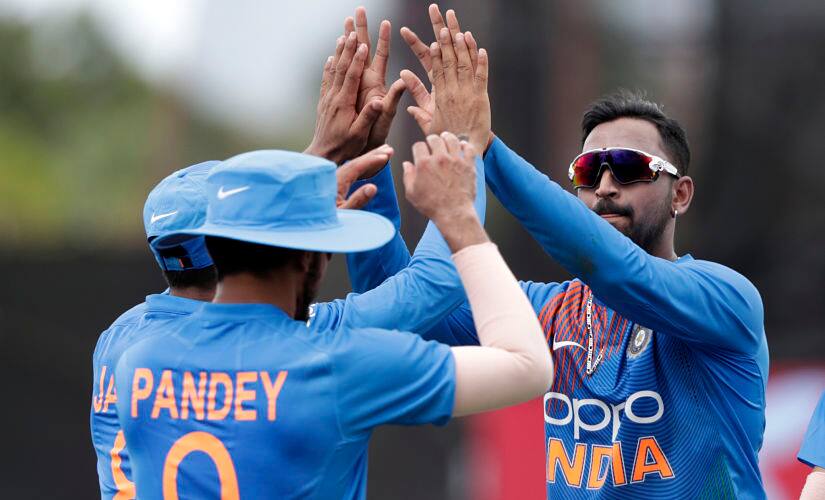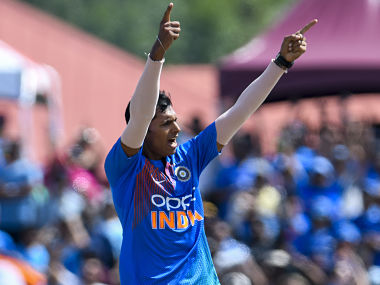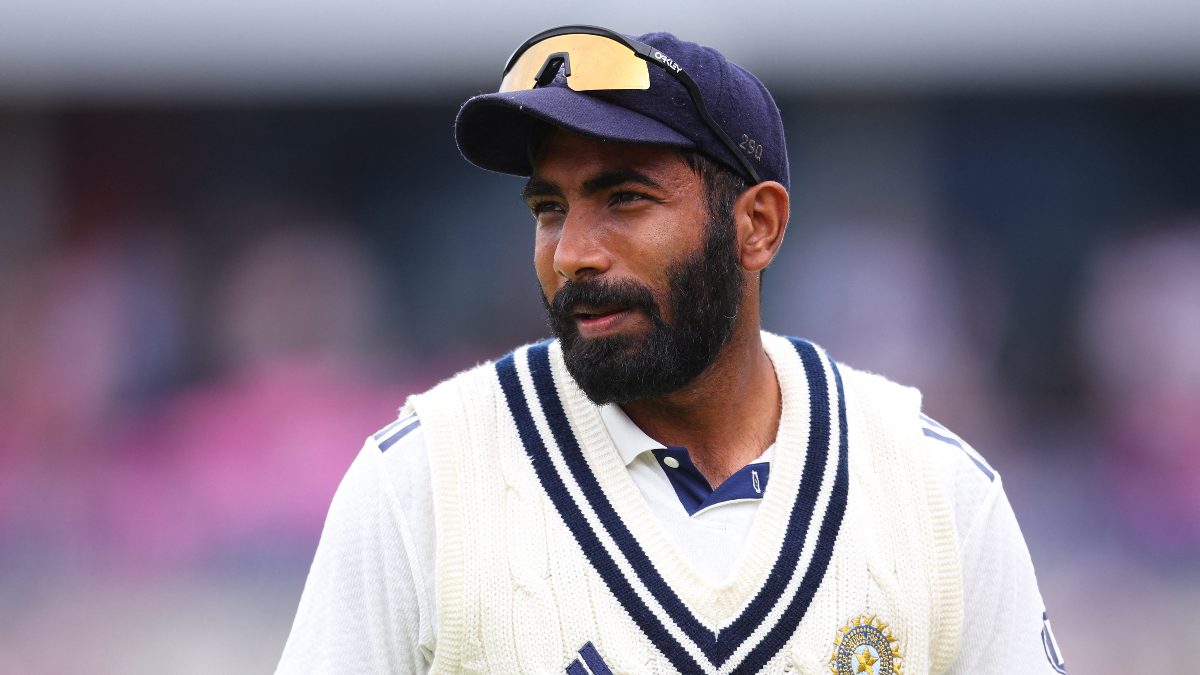With one eye on building the team for the World T20 World Cup 2020, the West Indies T20I series presented a chance for India’s fresh faces and comeback men to impress in their first audition – in the Caribbean. With increasing competition for places, pouncing on any opportunity is vital. Well, most players managed to impress as India completed their second consecutive bilateral series clean sweep over the West Indies in the USA and the Caribbean. Here are the key takeaways from the series. Deepak Chahar, Navdeep Saini provide a glimpse of the future: Navdeep Saini started off his international career with iridescent flourish and he couldn’t stop smiling after receiving the man of the match award on his debut. Saini was roped in for the series after consistent performances in IPL, domestic cricket and for the ‘A’ team and he carried the upswing in the international arena. [caption id=“attachment_7126621” align=“alignnone” width=“825”] Navdeep Saini celebrates after taking the wicket of Shimron Hetmyer in 1st T20I. AP[/caption] The 26-year-old finished as the highest wicket-taker in the series with five wickets from three matches at an average of 15.60 (second-best), strike-rate of 13.2 (best for players to have bowled more than four overs) and an economy rate of 7.09. The Delhi pacer’s incisive mind, adaptability and ability to bounce back stood out. There were signs of nerves early on but those disappeared after two wickets in two balls in his first over. After being clattered for a six straight back over his head off a good length ball by Nicolas Pooran, Saini bounced back immediately by adjusting his length and dismissing the West Indies No 3 off a short delivery. Another short delivery off the next delivery forced Shimron Hetmyer to chop it on his stumps. The Delhi pacer returned to bowl a wicket-maiden in the final over which included the wicket of a well-set Kieron Pollard. He cleverly adjusted his line and length to very full outside off and frustrated Pollard before trapping him leg before wicket. The second T20I was a minor blip with figures of 3-0-27-0 but he recovered for the third T20I by mixing his pace astutely and once again dismissing the in-form and menacing Pollard (58 off 45 balls) by beguiling him with a slower ball, after Saini had broken the 66-run stand between Pooran and Pollard in the previous over by sending back the former. Saini did end up conceding 16 off the final over which inflated his figures, but he will only learn with these experiences and this start in the international arena will nothing but inject confidence. Deepak Chahar was just two international matches old, but the way he swung the new ball in Guyana during his first opportunity in the series, he gave an impression of a seasoned campaigner. The wily mix of inswing and outswing confounded and demolished the West Indies top-order. Chahar finished with staggering figures of 3-1-4-3. Chahar has been playing a similar role consistently for Chennai Super Kings in the Indian Premier League (IPL) and been a go-to bowler for MS Dhoni in the powerplay. Chahar’s ability to swing it at a decent pace – in late 130s and early 140s – coupled with his accuracy makes him an enticing option for the captain. Besides from his skill to move the ball, Chahar also has a knack of building pressure by lining dot balls at the start of the innings. He is a thinking bowler and it can be gauged by his comments post the Guyana T20I. “It usually takes me the first two balls to judge whether there is swing or not,” Chahar told the host broadcaster after the match. “If my first couple of balls don’t swing, then it means it’s not going to swing; I need to shorten my length and use my variations more. If it’s swinging, I use fewer variations. Since there was moisture in the surface, and the ball was seaming and swinging both, I decided to go fuller.” Kohli even put his new-ball skills on par with Bhuvneshwar Kumar after the third T20I. “The way he swings it and the areas he bowls in, he puts the batsman in a lot of trouble,” Kohli said during the presentation ceremony. “With the new ball, his skills are right up there (with Bhuvneshwar’s), swinging it both ways and getting a lot with the new ball in any conditions, and that has been his USP in the IPL as well.” In India’s fast bowling arsenal, only Jasprit Bumrah’s place is assured. Saini and Chahar have provided a glimpse of the future with their performances in the T20I series. Consistency will be the key now to seal a place in the side especially competing with names like Bhuvneshwar Kumar, Mohammed Shami and Umesh Yadav. The Indian pace bowling arsenal has now started looking more lethal than ever. Rishabh Pant finally switches on finisher mode When you are earmarked as a special talent, the spotlight will naturally and perpetually follow you. Rishabh Pant is the latest one experiencing it. With the prodigious talent he possesses, he’s been constantly under the microscope with every move of his dissected and pored over. One of his biggest criticism has been his failure to finish off matches. He has elicited mixed emotions in his career so far. With each failure the frustrations have shot up but they’ve been fraught with ‘We need to keep patience with this young kid’ argument. Ahead of the series, Kohli had described how Pant had the chance to be a consistent performer in absence of MS Dhoni and how it was an opportunity to show his credentials and unleash his potential. [caption id=“attachment_7126641” align=“alignnone” width=“825”]
 Rishabh Pant finished the third T20I off in style with a six. AP[/caption] Pant didn’t click in the first two matches and faced just five balls and scoring four runs across those games, including a golden duck. The frustrations and murmurs naturally grew. When he walked out to bat at the fall of KL Rahul’s wicket at 27/2 in Guyana, the expectations unsurprisingly shot up. This was his chance to be the match-winner that everyone expects him to be every game. He finally stood up to the occasion and hit 42-ball 65 with a balanced mix of caution and aggression. More importantly, he applied himself and remained unbeaten till he finished the game with a six. Naturally, his captain was happy with Pant’s finishing job but also reiterated the need to give him space. “For the first two games, he was disappointed that he didn’t get any runs,” Kohli said. “He was playing really well, hitting the ball really well, but that’s how T20 cricket goes. Sometimes you don’t have the rub of the green. But today he made sure he applied himself and batted to his skills and backed himself to hit the big shots when required and really played with the tempo of the innings. “He’s got a lot of skill and talent. (But) it’s about winning and finishing games like these and gaining confidence, which he wants to do as well. It’s about giving him a bit more space to ease himself into international cricket and not putting too much pressure because of the way he’s played in the IPL. “At the international level, you need to tackle pressure differently and play yourself into the whole set-up. He has come a long way since he started. If he plays like this more regularly, we will see his potential shine for India.” The second opening slot is still open With Rohit Sharma’s spot sealed at the top of the batting order, the competition for the second opener’s slot is hotting up. Shikhar Dhawan looked rusty following his return from his injury and managed scores of 1, 23, and 3. For the most part, he didn’t look convincing and struggled to achieve the flow right through the series. He hasn’t had the best of times in the T20I arena this year averaging 15 from seven innings, striking at run-a-ball. He had a good IPL but the form dropped at the fag end. Competing with him for the spot is KL Rahul. [caption id=“attachment_7126771” align=“alignnone” width=“825”]
Shikhar Dhawan is cleaned up Keemo Paul during the second T20I. AP[/caption] Rahul, who was benched for the first two games, was brought in for the final T20I. He scored 20 from 18 balls. It’s difficult and unfair to rate him on the basis on just one innings and for that matter Dhawan too. However, the southpaw definitely needs to find his groove soon. It’s not a secret that the team management and selectors rate Rahul highly. And he’s backed that with numbers. The Kings XI Punjab opener was the second-highest run-getter in the IPL 2019 (593 runs at 53.90 with a SR 135.38) laying a path to redemption post the Koffee with Karan episode. In the two T20Is that preceded the IPL, Rahul scored 50 and 47 against Australia. The Karnataka opener averages 42.80 with two centuries and a strike rate of 148.10 in T20Is while Dhawan averages 27.28 with a strike-rate of 129.55 and no hundreds. The two will need to make most of the opportunities in order to seal the second opening slot. Washington Sundar can be a decent powerplay bowling option Another youngster making a comeback after a long injury lay-off was Washington Sundar. Prior to the West Indies series, the Tamil Nadu all-rounder had impressed in the seven matches he had played averaging 16.90 with 10 wickets. He didn’t get much of game time (three matches) in the IPL for RCB, but still did well enough in the series, especially with his bowling in the powerplay. He bowled in the first six overs in the opening two matches and started off with a wicket off the second ball of the series. In the next match, he started off with a maiden to Sunil Narine and finally forced him into submission in the second over to have figures of 2-1-1-1 in the powerplay. Overall, his powerplay figures read: 4-1-19-2. [caption id=“attachment_7126661” align=“alignnone” width=“825”]
 Washington Sundar celebrates the wicket of John Campbell in the 1st T20I. AP[/caption] In the two matches, Washington built pressure right from the start of the innings, which helped the bowlers from the other end. Sundar’s strength lies is his simplicity. He doesn’t try to experiment much and sticks to his strengths. His height provides an advantage and the lengths he hits gives the batsmen very little time to react and adjust. He chokes the scoring, builds pressure and forces the batsmen into making mistakes. Sundar doesn’t mind getting hit and has shown he has the mental strength to bounce back quickly. He has the best average in powerplay in T20Is since 2013 (min 100 balls) – 14.78 and best dot ball percentage as well - 60.61 percent.. He could provide a different dimension at the start of the innings and could be an x-factor on the bigger grounds in Australia. Over and above his bowling, he could be handy option with the bat too! However, it’s a tough road getting into the starting XI with spinners like Yuzvendra Chahal, Kuldeep Yadav, Ravindra Jadeja and Krunal Pandya in the mix. You can’t ignore Krunal Pandya While Hardik Pandya will come back after his break and claim his place into the XI, his elder brother, Krunal, is making a strong case of consistently playing alongside him. [caption id=“attachment_7126751” align=“alignnone” width=“825”]
 Krunal Panda (R) celebrates the wicket of Nicolas Pooran in the 2nd T20I. AP[/caption] Krunal has been steadily rising up the ranks since his IPL debut in 2016 and slowly becoming a key figure for the captain during pressure situations. He again showcased the value he brings with an all-round skills in the three T20Is which saw him pick the Player of the Series award. In the first T20I, he maintained the stranglehold in the middle overs with a frugal spell of 4-1-20-1. While in the second T20I, with India struggling to achieve momentum during the slog overs, he provided a late flourish scoring 20 off 13 balls including two sixes in the last over to propel India to a competitive 167/5. The confidence rubbed off on his bowling and he provided two important breakthroughs in the middle overs at a crucial juncture. He broke the 76-run stand between Rovman Powell and Nicolas Pooran that was threatening to explode sending back both the batsmen in the same over to derail the Windies. He had arrived in the series on the back of impressive performances against the West Indies ‘A’, where he picked seven wickets from three List A games including a five-for at 12.85 with an economy rate of 3.75. He also struck a 56-ball 45 in one of those games seeing his side out of further trouble when he walked out for 36/2. For a batsman who bats in the lower middle-order, Krunal possesses a decent average of 25.50 with a strong strike-rate of 132.46 in T20Is. He has scalped 14 wickets from 14 matches at 31.57 with an economy rate of 7.96. At times he has gone for runs but he’s bounced back strongly. It’s his calm head and maturity that makes him an unignorable asset for Kohli.
Washington Sundar celebrates the wicket of John Campbell in the 1st T20I. AP[/caption] In the two matches, Washington built pressure right from the start of the innings, which helped the bowlers from the other end. Sundar’s strength lies is his simplicity. He doesn’t try to experiment much and sticks to his strengths. His height provides an advantage and the lengths he hits gives the batsmen very little time to react and adjust. He chokes the scoring, builds pressure and forces the batsmen into making mistakes. Sundar doesn’t mind getting hit and has shown he has the mental strength to bounce back quickly. He has the best average in powerplay in T20Is since 2013 (min 100 balls) – 14.78 and best dot ball percentage as well - 60.61 percent.. He could provide a different dimension at the start of the innings and could be an x-factor on the bigger grounds in Australia. Over and above his bowling, he could be handy option with the bat too! However, it’s a tough road getting into the starting XI with spinners like Yuzvendra Chahal, Kuldeep Yadav, Ravindra Jadeja and Krunal Pandya in the mix. You can’t ignore Krunal Pandya While Hardik Pandya will come back after his break and claim his place into the XI, his elder brother, Krunal, is making a strong case of consistently playing alongside him. [caption id=“attachment_7126751” align=“alignnone” width=“825”]
 Krunal Panda (R) celebrates the wicket of Nicolas Pooran in the 2nd T20I. AP[/caption] Krunal has been steadily rising up the ranks since his IPL debut in 2016 and slowly becoming a key figure for the captain during pressure situations. He again showcased the value he brings with an all-round skills in the three T20Is which saw him pick the Player of the Series award. In the first T20I, he maintained the stranglehold in the middle overs with a frugal spell of 4-1-20-1. While in the second T20I, with India struggling to achieve momentum during the slog overs, he provided a late flourish scoring 20 off 13 balls including two sixes in the last over to propel India to a competitive 167/5. The confidence rubbed off on his bowling and he provided two important breakthroughs in the middle overs at a crucial juncture. He broke the 76-run stand between Rovman Powell and Nicolas Pooran that was threatening to explode sending back both the batsmen in the same over to derail the Windies. He had arrived in the series on the back of impressive performances against the West Indies ‘A’, where he picked seven wickets from three List A games including a five-for at 12.85 with an economy rate of 3.75. He also struck a 56-ball 45 in one of those games seeing his side out of further trouble when he walked out for 36/2. For a batsman who bats in the lower middle-order, Krunal possesses a decent average of 25.50 with a strong strike-rate of 132.46 in T20Is. He has scalped 14 wickets from 14 matches at 31.57 with an economy rate of 7.96. At times he has gone for runs but he’s bounced back strongly. It’s his calm head and maturity that makes him an unignorable asset for Kohli.
From Deepak Chahar and Navdeep Saini providing a glimpse of future to Rishabh Pant finally switching on the finisher mode, key takeaways from the West Indies vs India T20I series
Advertisement
End of Article


)

)
)
)
)
)
)
)
)



